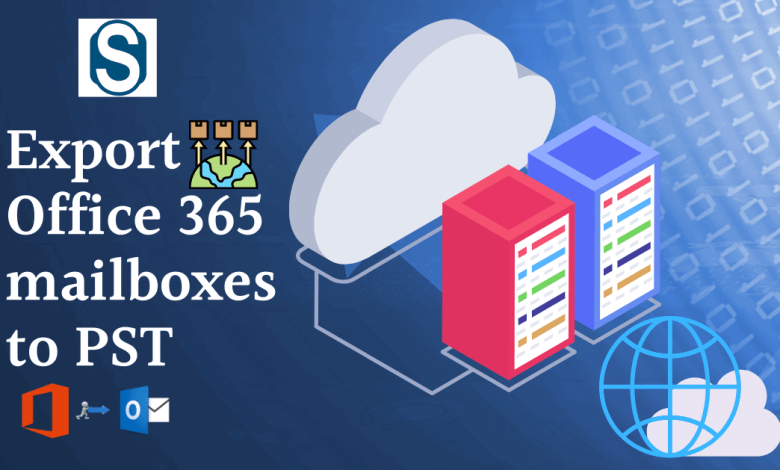Smart Way to Export O365 mailbox to PST – Solution Oriented

Most Microsoft clients save their Office 365 mailboxes to PST to locally back up their cloud content. The concern of Office 365 users is that they are uninformed of the conventional way to export Office 365 mailbox to PST. If you attempt to perform the task without knowing the exact process, you may lead to data loss, process hang, or the emergence of multiple errors. Hence, I have come up with this guide to help Office 365 users that how they can export O365 mailbox to PST file format.
Methods for exporting Office 365 mailboxes into PST
I have explained two methods to export or backup Office 365 shared mailbox in PST format. These are two such solutions:
- Manually exporting via eDiscovery tool.
- Use automated software to export quickly and safely.
-
Do Export using eDiscovery Tool:
Microsoft provided its users with a free inbuilt service called eDiscovery. Before moving with this method to Export Office 365 mailbox to PST, You should first get about the following steps:
- Administrative preferences and commands are mandatory for the account user.
- Be a member of eDiscovery Management Role Group
- Make sure you have Internet Explorer 8 or later to attempt this procedure.
- Additionally, you can use the Google Chrome web browser with the Click Once add-in installed.
- Requires Microsoft .NET Framework 4.7 and Windows 7 or higher OS version.
Once you have met all the above requirements, start the process to export the O365 mailbox to PST:
Get eDiscovery permissions for the user:
- Sign in to your source Office 365 tenant account.
- Click on Permissions under Security & Compliance Center. > eDiscovery Manager > Edit role group.
- Now, the Edit role group page will appear. Hit on the option Choose eDiscovery Administrator.
- Press Administrator > Edit >+ to make a new member as the eDiscovery Manager.
- A member list is displayed. Enable the checkbox here and click the Add for Office 365 button.
Create a New eDiscovery Instance:
- Go back from current page to Security & Compliance Center page and hit on Search & Investigation >> eDiscovery >> Create a case.
- Provide a wanted name in the Case namesection and write the specific description in the Description Click on Save.
Add Member to the New Instance
- Once more, go back to the Security & Compliance Center page and click on Search & Investigation >> eDiscovery.
- In the appearance list, find a newly created member. Click on the Open
- Continue with Export O365 export mailbox to PST by clicking on Addbutton on the Manage Role Group.
- After doing all the above actions, click on the Save At this step, a user mailbox can perform eDiscovery.
Content Searching
- In Security & Compliance Center, click Search & Investigation >> eDiscovery.
- Open the search tab and press on New Search
- There are append keywordsfor creating search content.
- In this wizard of under the locations, choose the desired content path.
- Select the option Specific Locationand Click on the Modify
- Now view all users, groups, teams, and sites located in your Exchange Online account.
- Choose the public foldersavailed in your plan.
- After following the above step, click on the Done >> Savebutton to export the Office 365 mailbox to PST.
- In the search tab, click on Save and Runto update all the defined settings in the account.
Export Searching Result:
- Click on the moredrag-down menu, then click the Export results option to export the O365 mailbox to PST.
- Go to the Exporttab, click on the desired search result.
- A new window appears, here hit on Download results.
You must copy it, as it will be required for in Click Once Application to paste.
- In the opened eDiscovery Search Tool, paste the copied key into the pop-up screen.
- Set the target location to save the resultant .PST file. Click on the Start
- Finally, select on Close button to export Office 365 mailbox to Outlook.
As discussed above, the eDiscovery method is not a reliable way to export O365 mailboxes to PST. Because of its many drawbacks and restrictions to complete the task. There is nothing to despair about in this. An automated solution for your query is provided. Let’s get describe it!
-
Use automated software for exporting Office 365 mailbox to PST:
Shoviv Exchange Recovery Manager Software is a one-stop solution. It provides users with many superb and user-oriented features. It enables a smooth process to export Office 365 mailboxes to PST. The software can recover data in different file formats. It also facilitates the restoration of PST file data to Exchange Online.
Highlighted features of this software:
- This Software from Shoviv enables users to add and export multiple (corrupted/non-corrupted) Office 365 mailboxes of any size to PST format at once.
- It also introduces a split option for the resulting large PST. This option helps users to set the size of PST files accordingly.
- The software also displays a preview of added mailbox items to verify the data status for exporting.
- There is a search item option on the subject, from, to, cc, bcc, from, item type, attachment name, read/unread message basis. You can include/exclude date range and message class.
- Incremental Export Feature: Sometimes, the process goes interrupted. The software will resume the interrupted process and prevent duplication by checking on this feature.
Wrapping up:
As per the above post and expert’s recommendation, the eDiscovery tool should not be competent to export Office 365 mailbox to PST. Use Shoviv Exchange Recovery Tool for the respective result without modifying the data integrity throughout the process. The software comes with a trial emulator version to measure its functionality before investing. It also exports the first 50 items per folder with all the respective innovations.




